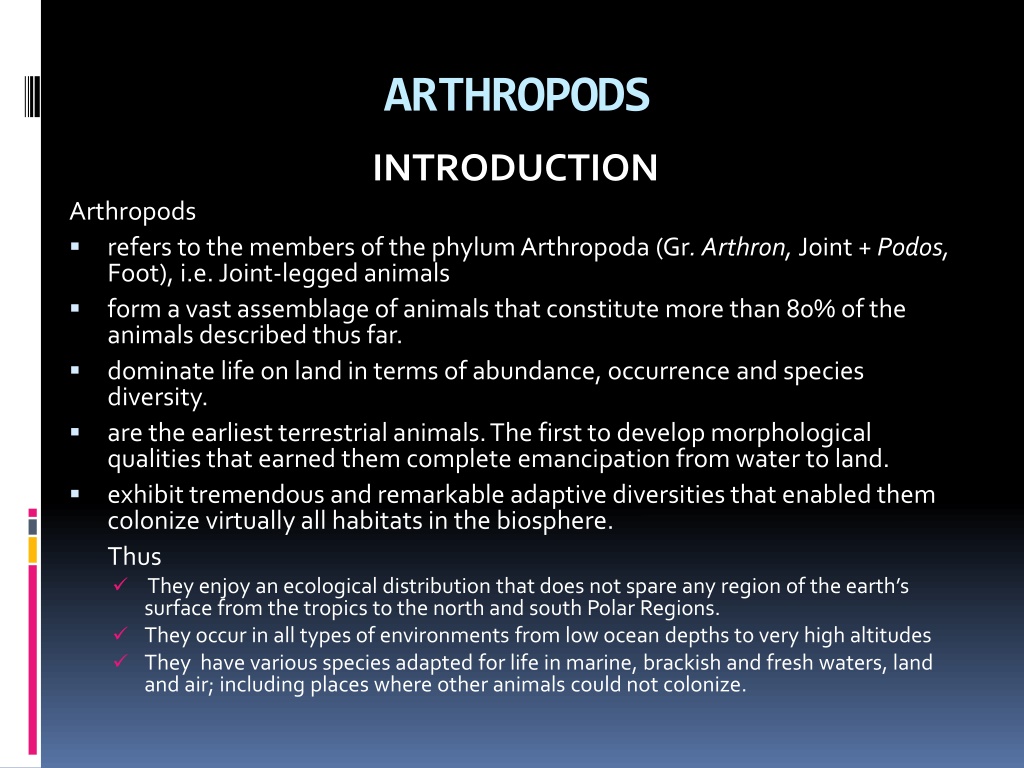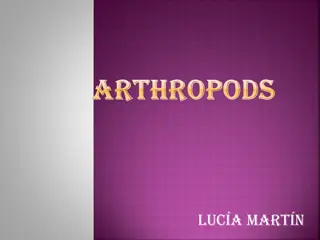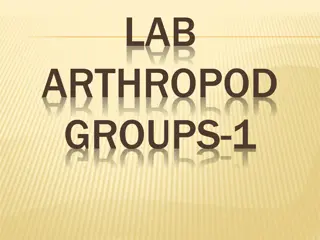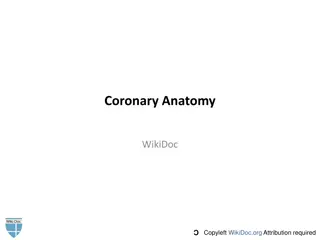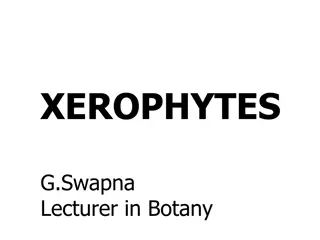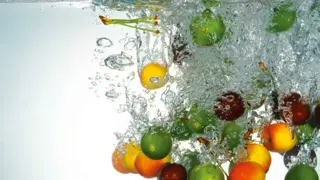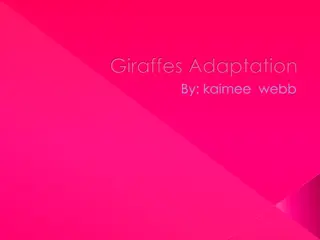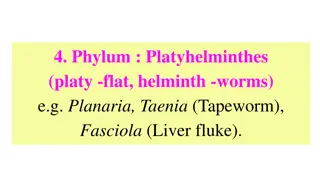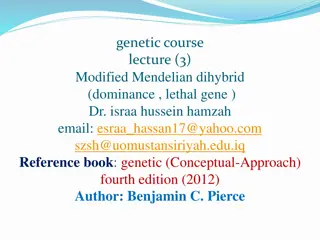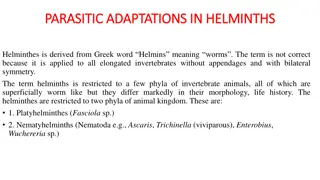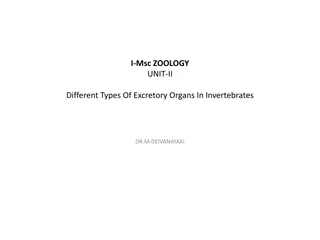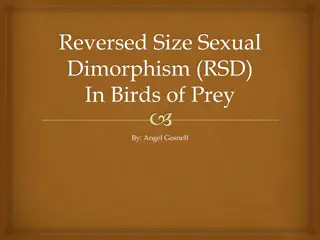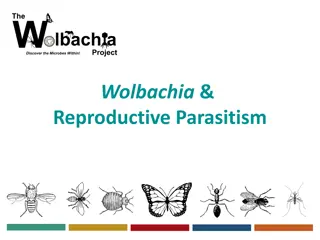Fascinating World of Arthropods: Incredible Adaptations and Ecological Dominance
Arthropods, joint-legged animals of the phylum Arthropoda, comprise over 80% of described animal species and exhibit remarkable adaptive diversities. They dominate various habitats, colonizing land, air, and water. Arthropods play significant ecological roles, with diverse feeding habits and efficient defense mechanisms. Originating from annelid-like ancestors, they possess characteristic features like a jointed exoskeleton and a unique nervous system. Their open vascular system showcases their intricate biological design and evolutionary success.
Download Presentation

Please find below an Image/Link to download the presentation.
The content on the website is provided AS IS for your information and personal use only. It may not be sold, licensed, or shared on other websites without obtaining consent from the author. Download presentation by click this link. If you encounter any issues during the download, it is possible that the publisher has removed the file from their server.
E N D
Presentation Transcript
ARTHROPODS INTRODUCTION Arthropods refers to the members of the phylum Arthropoda (Gr. Arthron, Joint + Podos, Foot), i.e. Joint-legged animals form a vast assemblage of animals that constitute more than 80% of the animals described thus far. dominate life on land in terms of abundance, occurrence and species diversity. are the earliest terrestrial animals. The first to develop morphological qualities that earned them complete emancipation from water to land. exhibit tremendous and remarkable adaptive diversities that enabled them colonize virtually all habitats in the biosphere. Thus They enjoy an ecological distribution that does not spare any region of the earth s surface from the tropics to the north and south Polar Regions. They occur in all types of environments from low ocean depths to very high altitudes They have various species adapted for life in marine, brackish and fresh waters, land and air; including places where other animals could not colonize.
INTRODUCTION CONTD Athropoda is the most influential animal phylum in all ecosystems due to its prominence, dominance and influence as a phylum play formidable ecological roles in thee functioning and sustenance of all ecosystems. mode of feeding in arthropods is highly varied their being no organic product that is not edible to them. are most capable of defending themselves against hazards or escaping from their enemies. They are the only group of invertebrates with flying members share numerous ecological niches, particularly the trophicniche, with man and they happen to be more efficient at food acquisition and utilization, hence the level of hatred by man against a more successful rival.
ORIGIN AND DIAGNOSTIC FEATURES OF ARTHROPODS Arthropods show affinities tending towards that of annelids and are believed to have evolved from annelid-like ancestors. The arthropod body plan shares some features with the polychaetes. These features include: Metamericsegmentation in respect of Body demarcations, muscular arrangement and Ganglion distribution on the ventral nerve cord. appendages per segment Distinct cephalisationwith appendages A confirmation of this is shown by Peripatus, a species on the verge of extinction in the Subphylum Onychophora, that exhibit both annelid and arthropod characteristics.
Characteristic features of Arthropods 1. They are triploblastic, bilaterally symmetrical, metamericallysegmented coelomates 2. Their entire body surface is covered by a cuticle that is stout, nonliving, noncellular, multilayered, chitinous, rigid exoskeleton secreted by the epidermis 3. All their appendages are jointed. This explains the name Arthropodawhich literarily means joint footed animals (Gr. Arthron, Joint + Podos, Foot) 4. Their muscles run in discrete bundles and movement is effected by lever system. 5. Their Central Nervous System consist of a dorsal brain, connected to a double, ventral, solid ganglionated nerve cord by a pair of circumoesophagealconnective 6. Their coelomis reduced to cavities of the gonads, pericardium and the haemocoel.
Characteristic features of Arthropods Contd They have open vascular system consisting of a dorsal contractible tubular heart with blood flowing in haemocoelic sinuses occasioned by the loss of intersegmentalsepta. They have a complete digestive gut that starts with a mouth equipped with variously modified appendages (mouthparts) and ends in an anus They have improved respiratory system equipped with structures like gills, book lungs and tracheal system to support the active and energetic arthropod individual whose body surface is no longer available for gaseous exchange 10. They have improved excretory system mediated by glands such as antennary, coxal or maxillary glands that functions as coelomoducts. Terrestrial forms engage a more efficient and water conserving malpighiantubules. 11. Growth is achieved by moulting or ecdysialprocess, which entails the removal of the hard cuticle that otherwise, limits growth in the animal and replacing it with a larger one. 12. Sexes are separate and development may be direct or indirect 7. 8. 9.
ARTHROPODAL SUCCESS Arthropodais the most successful phylum in the kingdom Animalia. Basis for this assessment include the following: Number of species: The fact that arthropods constitute not less than 80% of all the animals described thus far indicate that no other phylum in the animal world can boast of a representation greater than one fifth of Arthropoda. The arthropod situation turns out better when the fact that the 20% non arthropod types is shared by more than 12 phyla that include the chordates. Number per species: Each time an arthropod species is enumerated per unit space, the number of individuals per species and total number of arthropods usually outnumber those of other individual species and phyla present. Particularly favouredin this argument are the social insect like termites, bees and the ants and peculiar arthropods such as the mites and locusts. Ubiquity: Arthropods are known to feature virtually everywhere in the biosphere. Unlike most other phyla that are restricted to certain peculiar habitats, arthropods occur in all forms of aquatic and terrestrial biomes. They also have varying forms of individual species that inhabit the various microhabitats of the various ecosystems.
ARTHROPODAL SUCCESS CONTD Territory acquisition:Wherever an arthropod decides to posses, they do so exceedingly well to a point that they become the most dominant animal species within the territory. This fete is usually achieved through the development of appropriate morphological, physiological and behavioural adaptations that places the arthropod at a vantage position for territory acquisition. This situation is particularly true for the flying arthropods. Food variety:An animal group that consumes a larger variety of food is obviously more biologically successful. Contrary to what obtains with most other animal phyla whose food range is restricted to what the environment provides or a special food type, the arthropods are known to consume all manner of organic materials. Indeed there is no known form of organic material that is not consumed by at least one arthropod.
ARTHROPODAL SUCCESS CONTD Defensive capability: Defensive attribute improves with advancement in evolution. In the lower animals passive modes with very slow and ineffective movement were largely involved. Arthropods perfected the passive mode and improved on their ability to effect swift movements that allowed easy escape from their enemies. This is also enhanced by their small size, abilities to fly and sting. These have made them better than the chordates. Influence on the human population: No other animal phylum has influence human destiny as much as arthropods and no other will. In the course of human history arthropods have played remarkable roles ranging from food to menace items. In contemporary times, arthropods are mainly viewed as pests, parasites and vector of diseases and man puts in place all within his reach economically to avoid or exterminate them. Apart from this man has found arthropods quite helpful, as quite an array of benefits are derived or derivable from them. Man therefore sees the study of arthropods as not only necessary but a basic need for meaningful existence.
IMPORTANCE OF ARTHROPODS Arthropods activities as far as man is concerned are either beneficial or detrimental. The most popular ones, however, are the detrimental activities put up by a few (<5%) of the arthropod species. Notable amongst these are: 1. Crop destruction: Some arthropods share similar ecological niche with man in respect of the utilization of crop resource as food. Man in an attempt to boost the production of the food undertakes agricultural activities and sees an enhanced competitor, the arthropod, as a pest that is out to negate his mission. 2. Resource depletion: Unfortunately every crop has a list of pests, that vary with regions, attacking it on the field and in the store, e.g. stem borers and weevil for maize. Thus crop protection against arthropod attack remains paramount in the mind of every farmer and to this end he commits some of his resource.
IMPORTANCE OF ARTHROPODS CONTD Disease transmission: Some pathogens take advantage of a close and inevitable rapport existing between man and some arthropods to encourage dissemination of the diseases they cause. The guilty arthropods in this case are those that interact directly with man, especially the blood suckers. The pathogen resident in the blood takes advantage of the interaction; sometimes develop to infective stage in the arthropod to actualize its transmission from one host to the other. Such diseases include malaria, onchocerciasis, trypanosomiasis, dracunculiasis, filariasis, etc 3. Livestock and pet destruction: Quite an array of arthropods form parasites of livestock cultured for agricultural purpose by man. These arthropods reduce productivity and market value of the livestock or pet and sometimes cause or transmit diseases amidst them, thus negating human interest. Tangible financial commitments often go into effort directed at ensuring that such losses are avoided, hence the effect, though it is indirect on man, is economic and substantial. Examples of such arthropods include the ticks, mite, mosquitoes, etc. 4.
IMPORTANCE OF ARTHROPODS CONTD Property destruction: Since all organic matters are edible to arthropods, unfortunately some of these matter are valuable to man, arthropods ones again contradict man s interest be destroying his possession. The organic matters of interest here are the nonliving ones such pieces of furniture, smoked fish, cloths, books, etc. The arthropods involved do not discriminate between valuable and invaluable matters. Once identified, the arthropod deals with the items the same natural way. Man however readily identify destructive arthropods such as termites destroying the roof of a building and maggots destroying partially smoked fish. 5. Nuisance feature: Sometimes arthropod s interaction with man may be casual and not desirable to man. He therefore objects to it and wants the interaction discontinued immediately. Unfortunately the ineffectiveness of the corrective mode instituted in the face on numerous and un-cooperating arthropods, makes man more worried and less efficient. Such intimidating stance with arthropods often constitutes an unimaginable nuisance that warrants change of location or outright disregard by man, e.g. the first major event that initiated Pharaoh s conviction to release the Israelites was the advent of locust menace (Exodus, 10: 13) and the unwelcome but unstoppable patronage of houseflies to a palm wine glass make the fly qualify as the only animal engendered with unquestionable right to share the king s drink. 6.
IMPORTANCE OF ARTHROPODS CONTD 7. Inconvenience and fright feature: Some arthropods are renowned and dreaded for their ability to inflict injury on man. Man often sees this action as unprovoked, deliberate and painful with fatal consequences. He therefore reacts negatively to their presence by attacking first. Some of the well known and dreaded arthropods are scorpions, spiders, bees, skirt and blouse, black ants, etc.. The inconvenience caused by barnacles in the maritime industry is another popular example of economic detriments caused by arthropods.
IMPORTANCE OF ARTHROPODS CONTD Some of the beneficial roles of arthropods include: 1. Maintenance of life support processes in the ecosystem: Arthropods play remarkable roles in ensuring that life support processes are upheld to the satisfaction of every member of the ecosystem. They form the most important and visible tool of nutrient recycling and energy flow in all ecosystems. Arthropods constitute a major component of a food web that ensures efficient nutrient transfer and energy flow particularly at the lower trophic level. Hence it not uncommon to find arthropods at all trophic levels and some initiating a trophic interaction on an otherwise discarded organic matter within the ecosystem.
IMPORTANCE OF ARTHROPODS CONTD 2. Food production: Arthropods play a key role in the production of food in the terrestrial ecosystems, as most natural fruits and seed are products of pollinatory activities of arthropods. Without these arthropods most entomophilous flowers will remain unpollinated and it shall become difficult to sustain food production and feed the populace. These arthropods however carry out this very important function unconsciously, since their interest is the nectar or pollen contained in the flower. Some popular pollinators include: butterflies, bees, beetles etc
IMPORTANCE OF ARTHROPODS CONTD 3. Food item: Arthropods have been a reliable food source to man since prehistoric times. Ancient and biblical records of arthropod consumption abound, e.g. Lev. 11: 21-22. Sometimes it is the bye product of the arthropod, e.g. honey and honey dew,that isconsumed bymanasfood.This food source has provided some comparative advantages to man in term of cost, availability and the occurrence of some beneficial supplements that proffer medical advantages. Although the art of feeding on arthropods is today seen as a relic of barbarism, it is still practiced and this varies with cultures. Arthropods such as termite reproductives and queens, crickets, crabs, crayfish, hoppers, etc, feature prominently in the list of edible arthropods fromthispartofthe world. shrimps, caterpillars, grass
IMPORTANCE OF ARTHROPODS CONTD 4. Commerce item: Arthropods, particularly the edible ones readily serve as dependable items of commerce. The type of arthropod on sale, however, varies with location and season. Most of them feature prominently in the markets when in season but appearing when off season in the processed form and round the year. Crayfish, prawn, lobsters, shrimps, Cirinaforda(manimani),and dung beetle (Ogongo) larvae feature prominently in Nigerian markets. 5. Aesthetic value: Arthropods are known to include very beautiful organisms wearing ingenious patterns that speak volume about nature. To most naturalist, arthropods typifies a bewildering complexity and captivating beauty that often catches the eye readily. It is therefore very common to find decorative items carrying colourful butterflies, beetles etc. Artifacts, buckles, broaches, hair clips, textiles, etc. are frequently designed after butterflies and beetles
IMPORTANCE OF ARTHROPODS CONTD Soil regeneration and enrichment: As a soil fauna, arthropods play significant roles in the formation and regeneration of soil fertility. Their activities encourage soil formation, ploughing, aeration and drainage. The death of these fauna also adds value to the humus content of the soil where they are resident. Some of the popular arthropods in this respect include the dung rollers, dung beetles, maggots etc.. 6. Waste recycling and management: Organic wastes have become a major problem of human settlements particularly the urban settings. Some arthropods find use for these wastes and convert them to less disagreeable and readily useable forms in the ecosystem. Thus nutrients are regenerated and made available from a material previously regarded as a waste, within the ecosystem. This is then recycled and managed in favor of the entire system. 7.
IMPORTANCE OF ARTHROPODS CONTD 8. Biological control and environmental protection agents: Quite a number of arthropods have been used as biological control agents with remarkable efficiencies and success rates that are comparable to chemical control. Its low cost, safety, and sustainability makes it more preferable to chemical control, as it proffers advantages to the environmental, especially the coleopterans and the hymenopterans 9. Environmental protection agents: Arthropods constitute a very noteworthy harbinger within the human environment. This is informed by their remarkable sensitivity, precise and timely responses to situations within the environment. There occurrence or nonoccurrence in a particular system is a very reliable index for man as it signifies the exact situation proffered by the environment. Unfortunately man does not tap from this advantage and it has led to serious and fatal hardship incidences, e.g. Killer beans episode
IMPORTANCE OF ARTHROPODS CONTD 10. Source of peculiar products for food, medicinal and industrial uses: Some of the items formulated by some arthropods have found ready and acceptably use by man. He therefore recognizes them as coveted products that can be cropped to his benefit. Some common examples of these include honey from bee, cochineal from beetles, wax from bee, dye from beetles, various product reported to have medicinal value and silk from silk worms moths in fabric production. 11. Economic and industrial value: There no doubt that arthropods have constituted an economic block in the life of man through their activities. To abate or encourage these activities man commits a substantial amount of money, time and other resources. Some of the arthropod products are produced at the industrial level thus aiding the economy and generating employment opportunities. Apiculture and sericulture, i.e. beekeeping and raising silkworms, respectively have been listed as a cardinal areas for achieving the Millennium Development Goal (MDG).
IMPORTANCE OF ARTHROPODS CONTD 12. Source of learning and information: King Solomon recognizing the remarkable foresight, industry and economy of the ant directed lazy men to learn from the ways of the ant (Proverbs 6:6). Man over the years designed his appliances after one arthropod or the other, e g the volkwagen beetle car and the first set of war planes designed after the beetle and the dragon fly, respectively. Man may also has a great deal to learn from the social life of the bees and the termites to improve on his society. 13. Education and research value: The study of arthropods particularly those that impart adversely on man directly, i.e. insects and arachnids known as entomology and acarology, respectively have matured into distinct and vital scientific/biological study areas. They therefore form interesting integral part of biology curricula at the secondary and tertiary education levels. The need to also improve the interaction between arthropods and man warrants extensive research activities and quite a number of minds are engaged in the noble course.
ARTHROPODAL CUTICLE This is the major diagnostic feature of arthropods It is special because it combines the following characteristics It is nonliving It is non cellular It is multilayered, It is chitinous, It is hard, It is tough and It is resilient. It is exoskeletal It is secreted by the single layered hypodermis covering the entire body surface It extends inwards into the orifices of the gut and the tracheal system (Fig 1a) It provides protection and support while the inward inflections act as support frames and provide surfaces for muscular attachment.
ARTHROPODAL CUTICLE is a massive structure sitting on a single layered epidermis and a basement membrane (Fig 1b). It has two regions, i.e. 1. EPICUTICLE - a thin external non-chitinouslipoprotein layer often impregnated with wax and thus impermeable to water and 2. PROCUTICLE, a thick layer composed of three types of proteins, namely: i) Chitin, an aminopolyssacharide that is tough, resistant and insoluble in acid, alkali and water. ii) Arthropodin, and ordinary protein capable of undergoing a hardening process known as tanning or sclerotization on exposure (Arthropodin + exposure to air and light a hard and dark sclerotin), and iii) Resilina flexible and elastic protein. All three proteins bind together as a complex glycoprotein in the procuticle. Their distribution however distinguishes the procuticle into two regions; an outer EXOCUTICLE with tanned arthropodin(scelerotin), chitin and little resilin and is stronger and harder and may be further hardened by the presence of mineral salts as the case is with Crustaceans that carry CaCO3and CaPO4 deposits an inner ENDOCUTICLE with arthropodin, chitin and larger proportion of resilin.
SPECIAL FEATURES OF THE ARTHROPODAL CUTICLE The arthropod cuticle is a unique structure in so many respects and it is responsible for the success of the group. Some of the special features of the cuticle include: Impermeability: The epicuticleand its waxy property make the cuticle impermeable to water. It therefore prevents dehydration and makes land colonization possible Toughness: The occurrence of chitin in the procuticlemakes the cuticle very tough and resistant to most naturally occurring solvents. Thus arthropods are able to colonize and inhabit all habitats. Rigidity: The tanned arthropodin in the exocuticle proffer a hardness that ensures rigidity. A feature that is responsible for the utilization of the cuticle as support frame for muscles and the entire body. Resilience: The combined presence of resilin, arthropodin and chitin in the procuticleinforms a resilient cuticle that retains its posture after sustaining pressure. Thus the arthropod cuticle remains pliable, flexible and elastic. Adaptability: The arthropod cuticle is such that could be modified to suit the peculiar environmental challenges of the arthropod. Thus arthropods vary in cuticulardetails. Arthropodal appendages also witnessed differential cuticularmodifications to reflect the sensual, nutritional and reproductive needs of the animal.
SPECIAL FEATURES OF THE ARTHROPODAL CUTICLE CONTD This cuticle surrounds the body and the appendages but allows movement at discontinuous points This arrangement imposes segmental and jointed arrangements, respectively on the body and appendages of arthropods. Around each segment of the body therefore are four plates or sclerites, (fig1c) a dorsal Tergumor tergite, a ventral sternum or sterniteand two lateral pleurones/pleurites. Each appendage also has distinct regions separated by joints, each region answers specific names as shown in figs 1d&e. The discontinuous points between the sclerites, segments and the joints have flexible inter segmental or articular membranes representing the endocuticularpart of the procuticle. At these points the epicuticle and the exocuticle are reduced to very thin and ineffective structures overlaying the endocuticle and tucked in at an angle (fig 1f) to retain the cuticle properties.
Role and merits of the arthropod cuticle The cuticle is like suit of armor surrounding the arthropod. Its hardness, impermeability, toughness and resilience makes it a successful item that protectsthe soft inner tissues from desiccation and other risk factors associated with land colonization, against predators and pathogens and against pressures associated with living on land. It passively bestows shape and ready tool for identity to each arthropod, since members of the same population display characteristic morphological features typical of the population. It also providessupportfor an animal that is forced to bear its weight itself, since it has chosen to live on land with appendages strong enough to carry the arthropod. This support extends inwards with the incidence of support frames (apodemes) particularly in the head capsule. Some of the inflections readily serve as fixed pointsfor muscularattachment that enables the remarkable agility noticeable in arthropods relative to their wormlike annelid ancestors
Demerits of cuticle acquisition Hinders growth:The cuticle is not living and does not expand as the animal grows. It therefore put a stop to the growth of the animal unless it is shed and replaced with a larger one. Limits size:The weight of the heavy exoskeleton increases exponentially as the animal grows. Thus a large arthropod will not be able to carry /manage its size of cuticle, they are there fore forced to remain small. That the largest arthropods are crustaceans confirm this opinion, as the watery medium supports their weight. Exposes to danger:Moulting is energy sapping and leaves the individual involved vulnerable until the new cuticle harden. Such individuals are unable to withstand the various risk factors around them as the are not even capable of moving.
ARTHROPODISATION The serial changes that saw the advent of the present day arthropod from their annelidstock is known as artropodisation These changes are evolutionary and readily observable at the structural, functional and behaviourallevels. Most of the changes were repercussions of cuticle aquisistion, i.e. a major change that saw the advent of an individual that dwell on land without the attendant risk of losing water. Artropodisation implied that arthropods had stock with which they share some characters and there is the need to demonstrate it clearly: The annelid ancestral stock and the arthropods share the following general characteristics: Both are triploblastic, coelomate, metamarically segmented bilaterally symmetrical, have cylindrical, elongated body form guts are initiated by a small mouth and it ends in an anus, double ventral, solid and ganglionated nerve cord These similarities confirms that arthropods originate from annelids
ARTHROPODISATION CONTD The emergent arthropod differs from its ancestral annelid stock in so many regards some of which reflect their characteristics These include: Cuticle acquisition:The major change witnessed by the annelid stock was the advent of the hard, multilayered, chitinousexocuticle supeficially on an otherwise membranous cutaneoussurface. The arthropod unlike the annelid therefore became heavier, inflexible, better protected and far less prone to desiccation. Jointed appendages:Thenumerous straight chaetae located on all segment of the annelid ancestor will obviously not suffice the emerging arthropod. Appendages on the arthropod also require to be covered by the cuticle to counter desiccation, more so that it is to carry a heavier body. Muscles in bundles:The annelid muscles run in layers and acts on a hydrostatic skeleton but will not work on a rigid exoskeleton. Instead of this the arthropod effects their movement with muscles that run in discrete bundles of antagonistic opposing pairs within the jointed appendages. Lever mode of movement: The hydraulic system engaged by the annelid for its movement was put away by the arthropod for a lever system. Since there is a rigid exoskeleton and there are muscles to manage them, the slow and energy wasting hydraulic system was dropped.
ARTHROPODISATION CONTD Reduced coelom: The extensive coelomic fluid that forms the basis for the hydrostatic skeleton in the annelid is no longer required by the arthropod that sees it as extra weight. The arthropod therefore resolved to reduce the coelomic fluid and ultimately reduce the coelomic cavity, Open blood system with haemocoel: The annelid vascular system that is fully mediated by coelomic fluid is slightly modified in the arthropod due to the reduction in the fluid with the cavity transformed into a haemocoel (open sinus), heart altered to a tubular form with numerous chambers and paired lateral ostia and relocated to the dorsal side. Coelomoductsand malpighiantubules for excretion: The nephridia system utilized by the annelids is not only water wasting but encouraging desiccation as each segment has a nephridiopore. The arthropod therefore dropped the nephridiasystem for coelomoductcts that are restricted to specific segments and the malpighiantubleswith anus as the only outlet. Tracheal system for respiration: The cutaneous mode of gaseous exchange by the annelid ancestor has eluded the arthropod whose body surface is covered by a nonliving inpermeable cuticle. The arthropod consequently developed the tracheal system that allows gaseous exchange internally.
ARTHROPODISATION CONTD Limited size:Theburden of the weight of the cuticle on the arthropod limits the size attainable by the arthropod. The arthropod therefore despite its evolutionary advancement is smaller in bulk size relative to the annelid. Tagmatization: This is the grouping of adjacent metamericsegments for specialized roles within the organism. Thus giving a supra segmental arrangement known as tagma. Each tagmais marked off others and meant to perform a particular function for the entire organism, e.g. Thorax-centre for locomotion and respiration. It therefore ensures division of labourand efficiency. In the annelid stock the segments are uniform and performing similar function. Cephalization: The head tagmain the arthropod is particularly well developed and distinct with its appendages modified for sensory and ingestive functions. Ecdysialgrowth:The annelid had no problem growing, but the arthropod due to the nonliving cuticle cover experiences limited growth and hence grows in bouts. The arthropod is forced to cast off an small sized cuticle, secrets and begin to fill a new and larger one in a process known as Ecdysis or moulting process. In this process a hitherto hardened cuticle is shed and replaced by a larger newly formed cuticle.
THE MOULTING PROCESS is an energy sapping hormonally regulated process. The major hormone responsible for moultingis ecdysone. Its secretion as controlled both intrinsically by a circadian rythymeand by various environmental stimuli. is initiated by the detachment of the old cuticle from its epidermis and the formation of a new epiciticle on the surface of the epidermis. A moultingfluid composed of enzymes, i.e. chitinaseand protease is secreted by the glands under the epidermis are passed across the new epicuticleand deposited or accumulates at the sub cuticularspace below the old cuticle. These enzyme initiate the digestion of the old cuticle and the digested products are absorbed and utilized for the formation of a new procuticlebelow the new epicuticle. The new cuticle is protected from digestion by the lipid in the new epicuticle. The secretion of the new procuticlecontinues while the old one is being digested. The old cuticle eventually loose its colouration, ruptures and opens at the weak point on the ecdysial cleavage lines to permitting the exit of the moultingindividual. The newly formed soft, pliable and pale cuticle is stretched by the uptake of water and air to attain a larger size. At this short period the moultingindividual is exposed to so much risk and so the individual withdraws to a very remote part and remain quiescent. The cuticle is subsequently tanned to accomplish the hard and dark feature of an arthropod cuticle. At this point moultingis concluded and the arthropod is ready to go into full activity. Moultingprocess lasts two to five days, usually out of public glare and more importantly ridden by inactivity. and most arthropods stop moultingon attaining sexual maturity.
